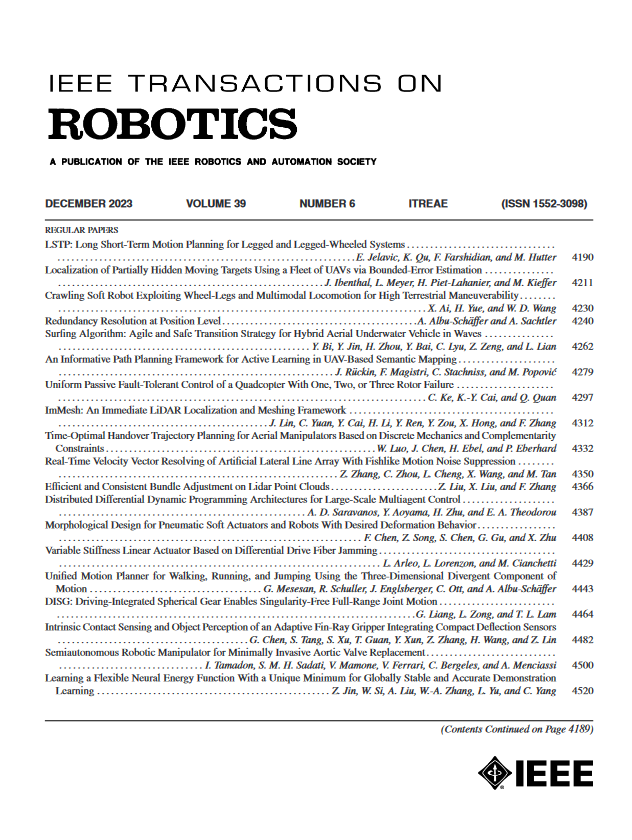控制移动机器人机械和计算资源的协调方法
IF 9.4
1区 计算机科学
Q1 ROBOTICS
引用次数: 0
摘要
移动机器人机械部件和网络部件的能量管理包括两个运行时并行运行的过程。这两个过程都可以显著提高机器人的电池寿命,进一步延长任务时间。在每个过程中,捕获和分析其中一个部分的能耗信息,以操纵机器人中的各种机械/计算执行器,例如电机速度和CPU电压/频率。在这篇文章中,我们表明,考虑管理机械和计算部分分开并不一定导致一个能量最优的解决方案,由于他们的共同依赖;因此,需要运行时共同管理方案。本文提出了一种主动能量优化方法,利用动态训练的内部模型预测移动机器人未来机械和计算部分的能量消耗,并在此基础上确定运行时的最佳机械速度和CPU电压/频率。在地面轮式机器人上的实验结果表明,与最先进的方法相比,总能耗降低了36.34%。本文章由计算机程序翻译,如有差异,请以英文原文为准。
A Coordinated Approach to Control Mechanical and Computing Resources in Mobile Robots
Energy management of mechanical and cyber parts in mobile robots consists of two processes operating concurrently at runtime. Both the two processes can significantly improve the robots' battery lifetime and further extend mission time. In each process, information on energy consumption of one of the two parts is captured and analyzed to manipulate various mechanical/computational actuators in a robot, such as motor speed and CPU voltage/frequency. In this article, we show that considering management of mechanical and computational segments separately does not necessarily result in an energy-optimal solution due to their co-dependence; as a consequence, a runtime co-management scheme is required. We propose a proactive energy optimization methodology in which dynamically trained internal models are utilized to predict the future energy consumption for the mechanical and computational parts of a mobile robot, and based on that, the optimal mechanical speed and CPU voltage/frequency are determined at runtime. The experimental results on a ground wheeled robot show up to 36.34% reduction in the overall energy consumption compared to the state-of-the-art methods.
求助全文
通过发布文献求助,成功后即可免费获取论文全文。
去求助
来源期刊

IEEE Transactions on Robotics
工程技术-机器人学
CiteScore
14.90
自引率
5.10%
发文量
259
审稿时长
6.0 months
期刊介绍:
The IEEE Transactions on Robotics (T-RO) is dedicated to publishing fundamental papers covering all facets of robotics, drawing on interdisciplinary approaches from computer science, control systems, electrical engineering, mathematics, mechanical engineering, and beyond. From industrial applications to service and personal assistants, surgical operations to space, underwater, and remote exploration, robots and intelligent machines play pivotal roles across various domains, including entertainment, safety, search and rescue, military applications, agriculture, and intelligent vehicles.
Special emphasis is placed on intelligent machines and systems designed for unstructured environments, where a significant portion of the environment remains unknown and beyond direct sensing or control.
 求助内容:
求助内容: 应助结果提醒方式:
应助结果提醒方式:


